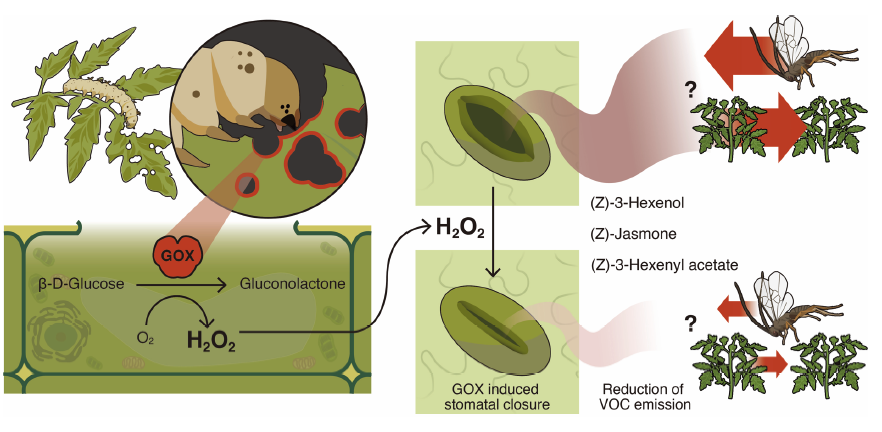Caterpillars can close leaf stomata, thereby reducing plant defense mechanisms

Graphical summary. Salivary glucose oxidase (GOX) of Helicoverpa zea larvae induces stomatal closure and inhibits emission of HIPVs involved in plant communications and defenses. The direct involvement of H2O2 is speculative.
Authors
Lin PO, Y Chen, D Chaverra-Rodriguez, CC Heu, NB Zainuddin, JS Sidhu, M Peiffer, CW Tan, A Helms, D Kim, J Ali, JL Rasgon, JP Lynch, CT Anderson, GW Felton
Download
Abstract
- Herbivore-induced plant volatiles (HIPVs) are widely recognized as an ecologically important defensive response of plants against herbivory. Although the induction of this “cry for help" has been well-documented, only a few studies has investigated the inhibition of HIPVs by herbivores, and little is known about whether herbivores have evolved mechanisms to inhibit the release of HIPVs.
- To examine the role of herbivore effectors in modulating HIPVs and stomatal dynamics, we conducted series of experiments combining pharmacological, surgical, genetic (CRISPR-Cas9) and chemical (GC-MS analysis) approaches.
- We show that the salivary enzyme, glucose oxidase (GOX), secreted by the caterpillar Helicoverpa zea on leaves, causes stomatal closure in tomato (Solanum lycopersicum) within 5 min, and in both tomato and soybean (Glycine max) for at least 48 h. GOX also inhibits the emission of several HIPVs during feeding by H. zea, including (Z)-3-hexenol, (Z)-jasmone, and (Z)-3-hexenyl acetate, which are important airborne signals in plant defenses.
- Our findings highlight a potential adaptive strategy where an insect herbivore inhibits plant airborne defenses during feeding by exploiting the association between stomatal dynamics and HIPV emission.

